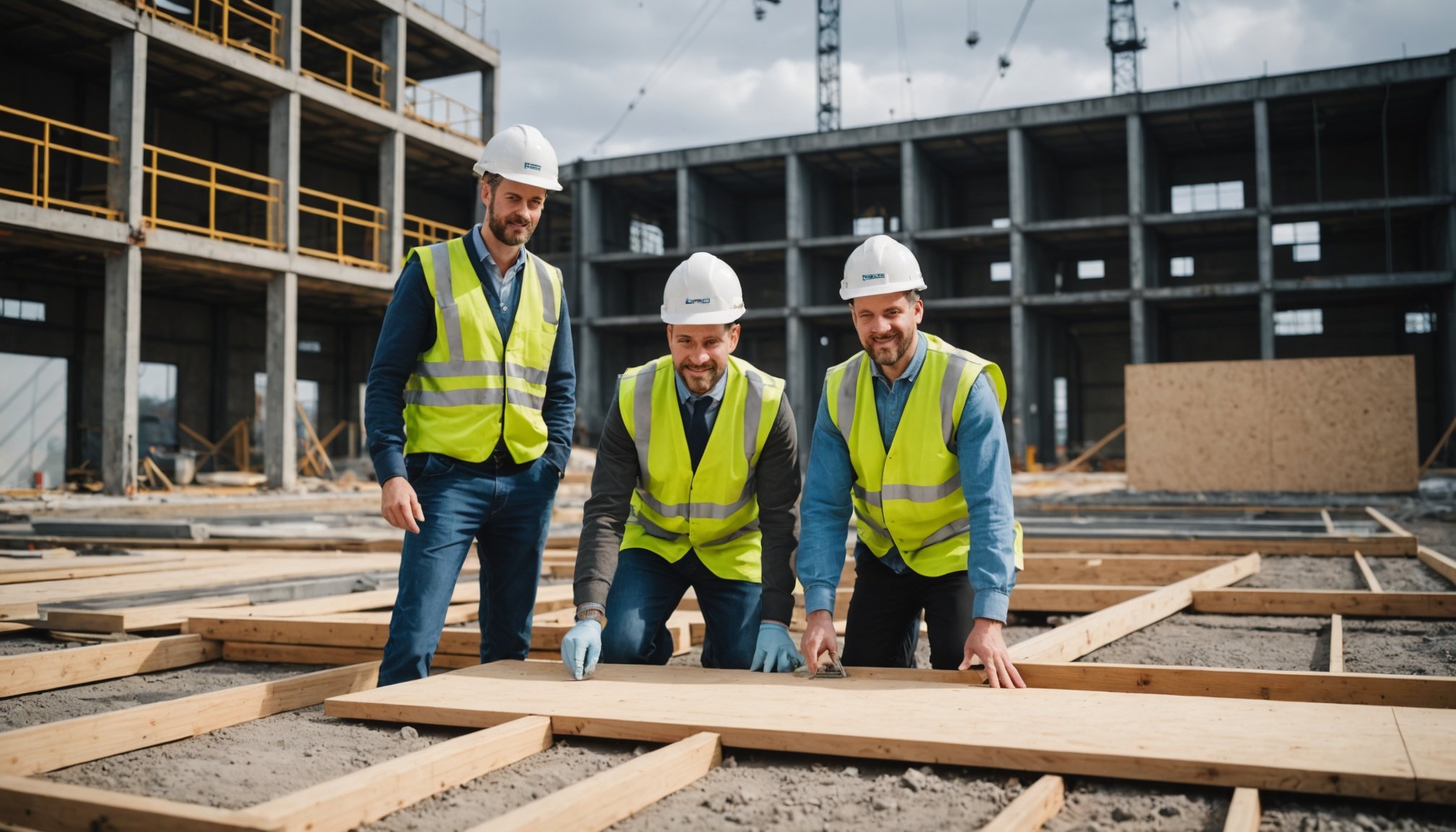Your Ultimate Blueprint for Launching a Sustainable Construction Business in the UK: Key Steps to Success
Understanding the Landscape of Sustainable Construction in the UK
As the world grapples with the challenges of climate change, the construction industry in the UK is undergoing a significant transformation. The UK government’s commitment to achieving net zero carbon emissions by 2050 has set a clear direction for the sector. For those looking to launch a sustainable construction business, understanding this landscape is crucial.
The UK Green Building Council’s (UKGBC) Advancing Net Zero programme is a cornerstone of this effort. Launched in 2018, this initiative aims to lead the UK’s transition to a net zero built environment by 2050. The programme focuses on defining, enabling, implementing, and advocating for net zero carbon building principles across all areas of the supply chain and in both new and existing buildings[1].
In parallel : Best website for learning english with native teachers
Building a Strong Foundation: Key Steps to Launch Your Business
Defining Your Business Model
Before diving into the operational aspects, it’s essential to define a robust business model that aligns with sustainability goals. Here are some key considerations:
- Decarbonisation Strategy: Develop a clear decarbonisation strategy that outlines how your business will reduce emissions across all stages of construction projects. This includes embodied carbon in materials, operational energy use, and end-of-life recycling or reuse.
- Industrial Strategy: Align your business model with the UK’s industrial strategy, which emphasizes innovation, skills, and infrastructure. This can involve adopting advanced technologies like Building Information Modeling (BIM) and prefabrication techniques[2].
- Sustainability Construction: Embed sustainability into every aspect of your business. This includes using eco-friendly materials, implementing sustainable supply chain management, and focusing on energy-efficient practices.
Securing Funding and Support
Launching a sustainable construction business often requires significant investment. Here are some ways to secure funding and support:
In parallel : Best website for learning english with native teachers
- Government Incentives: The UK government offers various incentives and grants for businesses committed to sustainability. For example, the Green Homes Grant and the Industrial Energy Transformation Fund can provide financial support for sustainable projects[4].
- Partnerships and Collaborations: Collaborate with other stakeholders, including suppliers, technology providers, and government agencies. Stronger stakeholder engagement can improve capabilities and reduce risks. For instance, the UKGBC’s Advancing Net Zero programme offers partnerships and forums that can be invaluable for new businesses[1].
Managing Sustainable Construction Projects
Project Management
Effective project management is critical for the success of any construction project, especially those with sustainability goals. Here are some tips:
- Whole Life Carbon Assessments: Conduct whole life carbon assessments to understand the carbon footprint of your projects from construction to demolition. This involves using tools like Environmental Product Declarations (EPDs) and life-cycle assessments (LCAs)[5].
- Renewable Energy and Energy Storage: Integrate renewable energy sources and energy storage solutions into your projects. This can include solar panels, wind turbines, and battery storage systems to reduce reliance on fossil fuels.
- Transport and Logistics: Optimize transport and logistics to reduce emissions. This can involve using electric or hybrid vehicles, planning routes efficiently, and minimizing the need for long-distance transport.
Sustainable Materials and Supply Chain Management
Using sustainable materials and managing the supply chain effectively are vital components of sustainable construction.
- Eco-Friendly Materials:
- Recycled materials (e.g., recycled steel, reclaimed wood)
- Low-emission concrete
- Bamboo
- Locally sourced materials to reduce transport emissions[3]
- Sustainable Supply Chain Management:
- Work with suppliers certified for sustainability (e.g., FSC-certified wood suppliers, ISO 14001-certified vendors)
- Ensure transparency about environmental practices, sourcing methods, and manufacturing processes
- Innovate and improve sustainable practices across the entire supply chain[3]
Compliance with Regulatory Changes
The UK construction industry is facing several regulatory changes that aim to enhance sustainability and reduce carbon emissions.
Construction Products Regulation and UK CBAM
- UK Carbon Border Adjustment Mechanism (CBAM): This mechanism will impose a carbon price on imported goods, ensuring that imports face the same carbon costs as domestically produced goods. Accurate reporting of embodied carbon and the use of EPDs will be essential for compliance[5].
- EU Ecodesign for Sustainable Products Regulation (ESPR): Although primarily EU-focused, this regulation will impact UK manufacturers exporting to the EU. It mandates stricter sustainability criteria for products, including energy efficiency, durability, and recyclability[5].
Net Zero Carbon Building Standard (NZCBS)
- Launched in 2023, the NZCBS provides a comprehensive framework for achieving net-zero carbon in building design, construction, and operation. It requires life-cycle assessments and emphasizes the use of EPDs to verify embodied carbon reductions[5].
Engaging with the Community and Industry
Building Relationships and Partnerships
Engaging with the community and industry is crucial for the long-term success of your sustainable construction business.
- Community Engagement: Foster good relationships with local communities by promoting sustainable practices and involving them in the decision-making process. This can include community workshops and public consultations.
- Industry Partnerships: Participate in industry forums and partnerships, such as the UKGBC’s Advancing Net Zero programme. These platforms provide valuable networking opportunities, access to best practices, and support for policy advocacy[1].
Advocacy and Policy Influence
Advocating for progressive policy interventions can drive higher performance across the market.
- Policy Advocacy: Engage with government agencies and industry bodies to advocate for policies that support sustainable construction. For example, the UKGBC’s programme advocates for mandatory embodied carbon assessments within UK Building Regulations[5].
- Industry Standards: Support and adhere to industry standards such as LEED (Leadership in Energy and Environmental Design) and the Net Zero Carbon Building Standard (NZCBS). These standards ensure that your projects meet global benchmarks for sustainability and energy efficiency[2].
Practical Insights and Actionable Advice
Steps to Make Your Construction Sites More Sustainable
Here are some practical steps to make your construction sites more sustainable:
- Use Eco-Friendly Building Materials: Opt for materials with lower carbon footprints, such as recycled materials, bamboo, and low-emission concrete.
- Implement Sustainable Supply Chain Management: Work with certified sustainable suppliers and ensure transparency in their practices.
- Reduce Water Consumption: Collect and reuse water, use water-efficient equipment, and monitor water usage to reduce waste.
- Focus on Eco-Friendly Site Operations: Reduce transportation needs, implement sustainable site offices, and promote a green culture by encouraging recycling and energy conservation[3].
Example of Successful Sustainable Construction Projects
The GCC region’s mega-projects, such as NEOM in Saudi Arabia, are excellent examples of how UK firms are revolutionizing sustainable construction. These projects integrate advanced technologies and green building certifications to achieve high sustainability standards. For instance, UK firms have used BIM software and prefabrication techniques to enhance project efficiency and reduce environmental footprints[2].: Navigating the Path to Net Zero
Launching a sustainable construction business in the UK requires a comprehensive approach that includes a strong business model, effective project management, compliance with regulatory changes, and engagement with the community and industry.
As Emma Harvey, Director of Sustainability at the UKGBC, notes: “The transition to a net zero built environment is not just a necessity; it’s an opportunity for innovation and growth. By defining, enabling, implementing, and advocating for net zero carbon building principles, we can create a more sustainable future for all.”
Here is a summary of the key steps in a detailed bullet point list:
- Define Your Business Model:
- Develop a decarbonisation strategy
- Align with the UK’s industrial strategy
- Embed sustainability into every aspect of your business
- Secure Funding and Support:
- Explore government incentives and grants
- Form partnerships and collaborations
- Manage Sustainable Construction Projects:
- Conduct whole life carbon assessments
- Integrate renewable energy and energy storage solutions
- Optimize transport and logistics
- Comply with Regulatory Changes:
- Understand the UK CBAM and ESPR
- Adhere to the Net Zero Carbon Building Standard (NZCBS)
- Engage with the Community and Industry:
- Foster community relationships
- Participate in industry forums and partnerships
- Advocate for progressive policy interventions
- Implement Practical Steps for Sustainability:
- Use eco-friendly building materials
- Implement sustainable supply chain management
- Reduce water consumption and focus on eco-friendly site operations
By following this ultimate blueprint, you can set your sustainable construction business on the path to success, contributing to a greener, more sustainable future for the UK.
Table: Key Regulatory Changes and Their Impacts
| Regulatory Change | Description | Impact |
|---|---|---|
| UK Carbon Border Adjustment Mechanism (CBAM) | Imposes a carbon price on imported goods to prevent “carbon leakage” | Ensures domestic and imported goods face the same carbon costs; requires accurate reporting of embodied carbon[5] |
| EU Ecodesign for Sustainable Products Regulation (ESPR) | Mandates stricter sustainability criteria for products sold in the EU | Affects UK manufacturers exporting to the EU; emphasizes energy efficiency, durability, and recyclability[5] |
| Net Zero Carbon Building Standard (NZCBS) | Provides a framework for achieving net-zero carbon in building design, construction, and operation | Requires life-cycle assessments and emphasizes the use of EPDs to verify embodied carbon reductions[5] |
| Part Z Proposal | Advocates for mandatory embodied carbon assessments within UK Building Regulations | Ensures all new buildings meet strict embodied carbon limits; supported by industry bodies like RIBA and ASBP[5] |
This table highlights the key regulatory changes and their impacts on the construction industry, helping businesses prepare for a more sustainable future.











